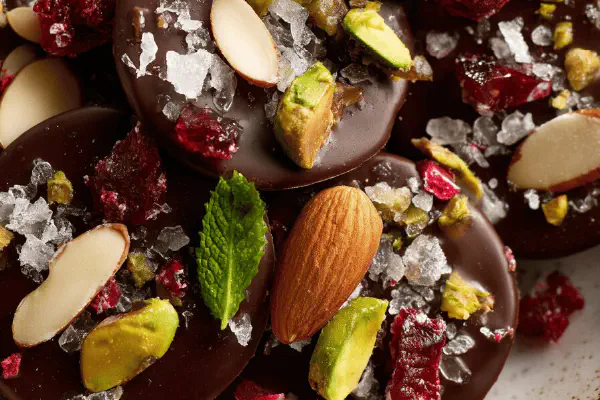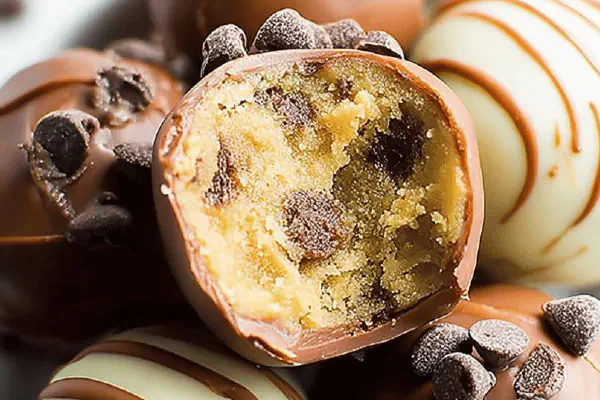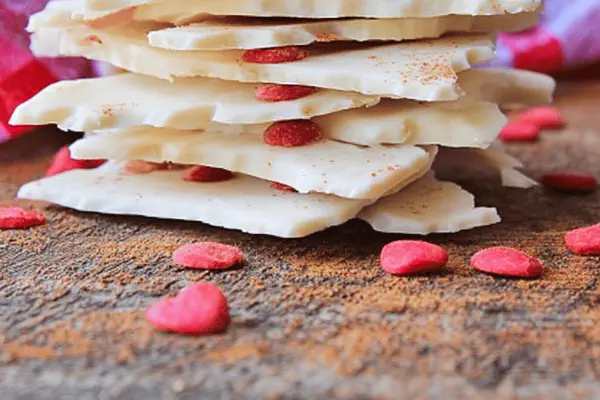Twisted Mendiants

By Emma
Certified Culinary Professional
Ingredients
Chocolate Base
- 235 g (8 oz) semisweet chocolate, roughly chopped
Toppings
- Toasted almonds slivered
- Shelled pistachios, chopped roughly
- Dried figs, diced small
- Dried cranberries
- Crushed peppermint candies
- Pinch of flaky sea salt
About the ingredients
Method
Preparation
- Line baking sheet with parchment. Important, prevents sticking, clean up quicker. Use a rimmed sheet because accidents happen.
Melting On Point
- Put half the chocolate in microwave-safe bowl. Heat 15 seconds, stir well. Listen for little crackles stopping means it's nearly soft. Repeat heating 15-second blasts max, stirring every round, melting must be gradual. Then add rest of chocolate; stir swiftly until silky but keep some lumps if stubborn. Residual heat finishes the melt without overheating. Overheating = grainy mess; trust your eye and feel; chocolate should shine.
Shaping Mendiants
- Drop level tablespoon-sized blobs spaced well apart. Use back of spoon to spread uneven rounds; not too thin or brittle, not too thick or gums up. Medium thickness ideal to hold garnishes. Shape is rustic; imperfection adds charm.
Garnishing — Go Quick, But Decisive
- Immediately scatter almonds, pistachios, figs, dried cranberries generously over each. Sprinkle crushed peppermint sparingly—adds crunch, unexpected bite. A sneaky pinch of flaky sea salt onto each disc. Salt wakes flavors, prevents cloying.
Setting Time and Sensory Cues
- Let sit at room temp until firm, about 50 minutes, depending on kitchen humidity. If impatient or room warm, slide into fridge for 12-18 minutes—watch that condensation. Chill too long, get dull surface. Touch test: firm but springy under finger with subtle give. This means ready to store or stack.
Storage Notes
- Keep in airtight container separated by wax paper layers. Shelf is 1 week room temp, up to 3 weeks refrigerated. Avoid freezer; chocolates' textures become gritty.
Troubleshooting
- If chocolate blooms (white streaks), didn’t temper properly or temp shock from fridge. Slightly slick, safe to eat but less pretty. Remelt gently, try slow microwave bursts or double boiler with water below boil, stirring constantly.
- If nuts stale or soggy, toast separately in dry pan until fragrant, cool completely before topping. Adds crunch and aroma.
- Sticky or melting toppings? If dried fruit moist, pat dry or roast briefly to reduce moisture.
- Too thick chocolate on spread? Next batch chill a minute on sheet before adding toppings to avoid sinking.
- Big batches tempt rushing; do small rounds, steady pace.
Tips and Variations
- Try dark chocolate mixed with a pinch of cinnamon or cayenne for heat kick. Or white chocolate with freeze-dried raspberries crushed instead of peppermint.
- Experiment with sea salt types—pink Himalayan gives subtle mineral notes.
- Use tongs or tweezers to place garnishes if quick precision desired.
- Visual is key. Shiny glossy chocolate indicates proper melting. Dull means overheat or moisture.
- Always keep equipment 100% dry; small water droplets wreck temper.
- Let cool fully on counter away from direct sunlight or heat sources.
- Clean parchment up quickly; chocolate sticks less once cooled.
Cooking tips
Chef's notes
- 💡 Heat chocolate in short bursts of 15 seconds max. Stir often to avoid grainy texture. Listen for subtle crackles—sign melting’s nearly done. Add remaining chunks late; residual heat finishes melt. Overheating kills shine. Slow patience wins here.
- 💡 Scatter nuts and fruits fast but decisive. Press toppings slightly into chocolate while still warm but not soft enough to sink. Medium thickness crucial. Too thin means brittle disks, too thick makes chewing tough. Rustic shape works; imperfections add charm and better chill hold.
- 💡 Watch flavor balance. Peppermint candies crushed coarsely for textural contrast; too fine and crunch's lost. Salt flakes must be flaky, not table salt. Salt brightens flavor, cuts chocolate’s sweetness, adds subtle pop. Skipping salt dulls overall taste.
- 💡 Keep everything dry. Damp bowls or utensils wreck temper fast. Use parchment-lined trays always; clean up fast, avoid stuck disks. Toast nuts dry in pan until fragrant—brown but no burn. Dried figs need to be firm, not sticky, or chocolate surface drags down.
- 💡 Test setting by feel not clock. Firm but springy under finger means ready to store or stack. Fridge can quick set but watch condensation and dull surface. Chill too long loses gloss. Room temp more forgiving humidity-wise but slower. Adjust based on kitchen.
Common questions
How do I avoid grainy chocolate?
Heat in short bursts, stir often, listen for crackles stopping means nearly melted. Add leftover chunks last; residual heat smooths. Too hot kills shine, causes grain. Slow melt beats rushing.
Can I swap nuts or fruits?
Absolutely. Tried almonds and pistachios—delicious with toasted crunch. Figs replaced apricots for chewiness. Cranberries tart balance sweetness. Use pumpkin seeds or dried pineapple for allergies. Keep firm, not moist toppings.
What if chocolate blooms?
Usually temper failed or temp shock from fridge. White streaks mean bloom; it’s safe but looks off. Remelt gently with slow microwave bursts or double boiler below boil. Constant stirring helps. Avoid fridge shocks if possible.
Best way to store mendiants?
Airtight container with wax paper layers recommended. Room temp good up to a week; fridge extends to three weeks. Avoid freezer—texture becomes gritty. Watch moisture buildup if refrigerated; condensation ruins gloss.



